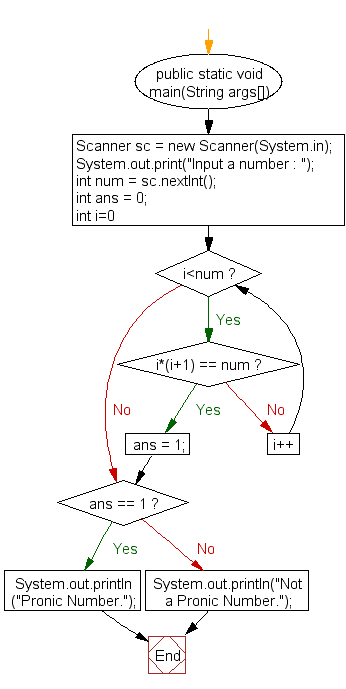Java Exercises: Check whether a number is a Pronic Number or Heteromecic Number or not
Java Numbers: Exercise-13 with Solution
Write a Java program to check whether a number is a Pronic Number or Heteromecic Number or not.
A pronic number is a number which is the product of two consecutive integers, that is, a number of the form n(n + 1).
The first few pronic numbers are:
0, 2, 6, 12, 20, 30, 42, 56, 72, 90, 110, 132, 156, 182, 210, 240, 272, 306, 342, 380, 420, 462 … etc.
Test Data
Input a number : 110
Pictorial Presentation:
Sample Solution:
Java Code:
import java.util.Scanner;
public class Example13 {
public static void main(String args[])
{
Scanner sc = new Scanner(System.in);
System.out.print("Input a number : ");
int num = sc.nextInt();
int ans = 0;
for(int i=0; i<num; i++)
{
if(i*(i+1) == num)
{
ans = 1;
break;
}
}
if(ans == 1)
System.out.println("Pronic Number.");
else
System.out.println("Not a Pronic Number.");
}
}
Sample Output:
Input a number : 110 Pronic Number.
Flowchart:

Java Code Editor:
Contribute your code and comments through Disqus.
Previous: Write a Java program to check whether a number is a Harshad Number or not.
Next: Write a Java program check whether a number is an Automorphic number or not.
What is the difficulty level of this exercise?
Test your Programming skills with w3resource's quiz.
Java: Tips of the Day
How to sort an ArrayList?
Collections.sort(testList); Collections.reverse(testList);
That will do what you want. Remember to import Collections though!
Ref: https://bit.ly/32urdSe
- New Content published on w3resource:
- HTML-CSS Practical: Exercises, Practice, Solution
- Java Regular Expression: Exercises, Practice, Solution
- Scala Programming Exercises, Practice, Solution
- Python Itertools exercises
- Python Numpy exercises
- Python GeoPy Package exercises
- Python Pandas exercises
- Python nltk exercises
- Python BeautifulSoup exercises
- Form Template
- Composer - PHP Package Manager
- PHPUnit - PHP Testing
- Laravel - PHP Framework
- Angular - JavaScript Framework
- Vue - JavaScript Framework
- Jest - JavaScript Testing Framework
